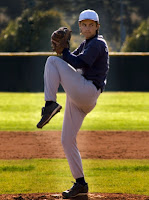Pitchers and the set position
April 11, 2011 by Coach McCreary
Filed under Pitching
When pitchers throw from the stretch, you’ll see a number of variations as to where they come set with their hands after getting the sign from the catcher. Some bring their hands together and come set (come to a stop) around chin level. Some come set at the chest. Some even stop down near the players belt. Is one better than the other? I think there is, especially for young pitchers. When I teach pitching, I recommend pitchers come set around belly button height. I also suggest coming to a stop with the glove (and the ball) facing down. Although a number of pitchers can be successful coming to a set position higher than belly button height, here are my reasons why belly button height with the glove facing down makes things easier:
Belly Button Height:
 |
| Photo 1: Belly button height with glove facing down |
Shortens arm path. To get the most out of his arm, a pitcher should be creating big circles when they throw. When the ball/hand leaves the glove, it must come down and then proceed a little bit back, up, and over to the release point. A big circle. Getting to the proper release point is one of the most important things a pitcher must do to be effective. Many pitchers, especially those who rush and go forward too fast, do not allow their arm enough time to travel through that circle to get to the best release point. Their job becomes even harder if the path is longer. Coming set at the chin as opposed to the belly button adds an additional foot to the distance the arm has to travel in its path to the release point. Pitchers certainly should be taught the mechanics of staying back longer to give their arm enough time but a quick adjustment that can have an immediate positive impact is to have them come set lower thus shortening the path.
Improved breaking pitches. For the same reasons described above. If a pitcher is late getting to his release point on a fastball when his arm speed is fastest, he probably is going to be very late getting there on his breaking pitches and change-up. The result is flat or hanging off-speed pitches up in the zone. Shortening the arm path gets more of those pitches to the proper release point which gets them down in the strike zone with better action (break, movement, etc) on the ball.
 |
| Photo 2. Fingers facing the sky, ball facing the chest, and usually an exposed wrist. |
Glove Facing Down:
Clears the path. Some pitchers come set with the glove in front of their chest with the glove fingers facing up towards the sky and the ball facing their body (Photo 2). This can create a problem related to the one explained above. Part of the glove (the heel) is under the ball and prevents the ball/hand from freely exiting the glove. This can create enough of a delay in the arm circle to not get to the release point in time. In Photo 1, Mariner’s pitcher Felix Hernandez has nothing under the ball making it easy for his hand to exit the glove and begin his arm path/circle. That is because his glove is facing down.
Hides the wrist. I admit it. I was a cheater. Well, sort of. When I batted, I looked for anything a pitcher did to tip off his pitches. This became much easier to do when I could see the pitcher’s throwing wrist when he came to the set position after getting the sign. When the pitcher comes set with the glove facing his chest (Photo 2), it exposes his wrist as he is gripping the ball. Variations in wrist position that can be seen by the batter often tip off when a certain pitch is coming. Holding the glove facing down when you come set not only allows for the ball to exit more freely, it hides the wrist from the batter as well.





Pitcher position plays a vita role in in a good bowl.